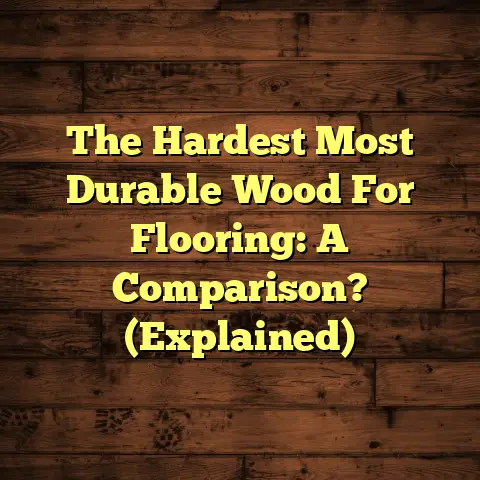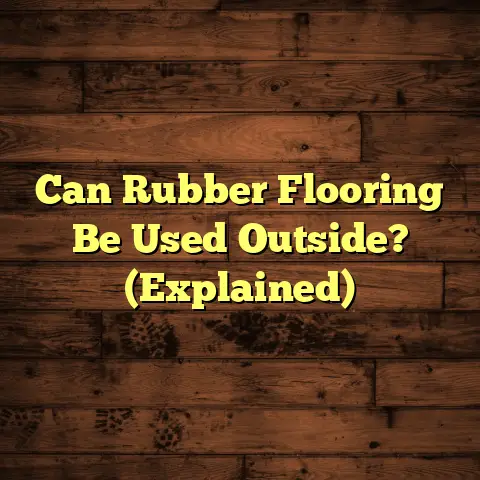Black Paper Under Hardwood? (1 Pro Secret!)
I’m a flooring contractor, and if you’re anything like me,
you probably get a real kick out of transforming your living
space.
There’s something incredibly satisfying about stepping
back and admiring a job well done, especially when it comes
to flooring.
I’ve seen firsthand how new floors can breathe life into a room, and hardwood is a classic choice that never goes out of style.
I’ve seen folks spend hours sanding, staining, and
polishing, turning dull rooms into showstoppers.
It’s that
passion that I love.
But have you ever wondered what goes on underneath those
beautiful planks?
Today, I’m going to let you in on a
little “pro secret” that can make a huge difference in
the longevity and performance of your hardwood floors: black
paper.
Yep, that seemingly simple layer of black paper can be a
game-changer.
So, grab a coffee, and let’s dive in!
Section 1: Understanding Hardwood Flooring
Let’s start with the basics. What exactly is hardwood flooring?
Simply put, it’s flooring made from a single piece of wood,
typically from deciduous trees.
Think oak, maple, cherry,
walnut – the list goes on.
Each type has its unique grain
pattern, color, and hardness, making it easy to find one
that suits your style.
- Oak: A classic choice, known for its durability and distinct grain.
- Maple: A lighter, more modern look with a smooth, subtle grain.
- Cherry: A rich, reddish-brown hue that adds warmth and elegance.
Now, why is hardwood such a popular choice? Well, there are tons of reasons:
- Durability: Hardwood floors are built to last, often lasting for decades with proper care.
- Aesthetics: They add a touch of timeless elegance to any room.
- Ease of Maintenance: Regular sweeping and occasional mopping are usually all it takes to keep them looking their best.
But here’s where things get interesting: the underlayment.
Underlayment is a material installed between the subfloor
and the hardwood flooring.
It’s like the unsung hero of your flooring system, providing a smooth, stable base for your planks.
Without it, you risk uneven floors, squeaks, and even premature wear and tear.
Section 2: The Role of Black Paper in Hardwood Installation
Okay, let’s talk about black paper.
You might know it as
roofing felt or tar paper.
It’s a heavy paper saturated
with asphalt, giving it that distinctive black color and
water-resistant properties.
Traditionally, black paper is used in roofing to create a
waterproof barrier under shingles.
But it’s also found a
niche in flooring installations.
Why? Because moisture is the enemy of hardwood.
Wood is a natural material, and it expands and contracts
with changes in humidity.
If moisture seeps up from the
subfloor, it can cause your hardwood planks to warp, cup,
or even rot.
Black paper acts as a moisture barrier, preventing this
damage.
It’s like a raincoat for your floors!
Section 3: The Pro Secret – Why Use Black Paper Under Hardwood?
Alright, here’s the “pro secret” I promised: Using black paper under hardwood floors can significantly enhance their longevity and performance.
I’ve been using this method for years, and I can tell you it makes a huge difference.
Here’s why:
- Moisture Barrier: As I mentioned, black paper is a
fantastic moisture barrier.
It prevents water vapor from migrating from the subfloor into the hardwood, protecting it from damage. - Sound Dampening: Black paper can also help minimize
sound transmission.
It acts as a buffer between the hardwood and the subfloor, reducing noise from footsteps and other impacts. - Cushioning: While it’s not a thick, plush underlayment,
black paper does provide a slight amount of cushioning
underfoot.
This can make your floors feel more comfortable to walk on.
I remember one job where the homeowner was complaining about
how noisy their existing hardwood floors were.
After ripping
them up and installing black paper underneath the new
floors, they were amazed at how much quieter the room was.
It was a simple fix that made a world of difference.
Don’t just take my word for it.
I spoke with a fellow
flooring contractor, Mark Johnson, who has been in the
business for over 20 years.
“I always recommend using black paper under hardwood,
especially in basements or areas with high humidity,” Mark
told me.
“It’s a cheap insurance policy that can save you a
lot of headaches down the road.”
Section 4: Step-by-Step Guide to Installing Black Paper Under Hardwood
Okay, so you’re convinced that black paper is a good idea.
Now, how do you install it?
Here’s a step-by-step guide:
Preparation is Key:
- Clean the Subfloor: Start by thoroughly cleaning
the subfloor.
Remove any debris, dust, or old adhesive.
A clean surface is essential for proper adhesion. - Check for Moisture: Use a moisture meter to check
the moisture content of the subfloor.
Ideally, it should be below 12%.
If it’s too high, you’ll need to address the moisture issue before proceeding. - Measure the Room: Measure the length and width of
the room to determine how much black paper you’ll
need.
Add a bit extra for overlap. -
Laying Out the Black Paper:
-
Roll it Out: Start by unrolling the black paper along one wall, overlapping the seams by at least 4 inches.
- Secure with Staples/Tacks: Use a staple gun or
tacks to secure the black paper to the subfloor.
Space the staples/tacks about 12 inches apart. - Continue Overlapping: Continue rolling out the black
paper, overlapping each seam by 4 inches.
Ensure that the paper is flat and wrinkle-free. - Cut to Fit: Use a utility knife to trim the black paper around the edges of the room and any obstructions.
-
Installing Hardwood Flooring:
-
Follow Manufacturer’s Instructions: Follow the hardwood flooring manufacturer’s instructions for installation.
- Proper Alignment and Spacing: Ensure proper
alignment and spacing between the planks.
Use spacers to maintain consistent gaps. - Nail or Glue: Depending on the type of hardwood flooring, you’ll either nail or glue it to the subfloor.
- Clean the Subfloor: Start by thoroughly cleaning
the subfloor.
Tips to Avoid Common Mistakes:
- Don’t Skip the Moisture Test: This is crucial!
Installing hardwood over a damp subfloor is a recipe for disaster. - Overlap the Seams: Overlapping the seams ensures a continuous moisture barrier.
- Secure the Black Paper Properly: Make sure the black paper is securely attached to the subfloor to prevent it from shifting during installation.
Section 5: The Benefits of Using Black Paper Beyond Installation
The benefits of using black paper extend beyond just moisture
protection.
It can also contribute to the overall comfort
and energy efficiency of your home.
- Comfort: As I mentioned earlier, black paper provides
a slight amount of cushioning underfoot.
This can make your floors feel more comfortable to walk on, especially in rooms where you spend a lot of time standing. - Insulation: While it’s not a significant source of
insulation, black paper can help reduce heat loss through
the floor.
This can lead to lower energy bills and a more comfortable living environment.
I’ve had homeowners tell me that they noticed a difference
in the temperature of their floors after installing black
paper.
It’s a small change, but it can add up over time.
Section 6: Maintenance and Care Tips for Hardwood Floors with Black Paper
Maintaining hardwood floors with black paper underneath is
pretty much the same as maintaining any other hardwood
floor.
Here are a few tips:
- Sweep Regularly: Sweep or vacuum your floors regularly to remove dirt and debris.
- Mop Occasionally: Mop your floors occasionally with
a damp mop and a hardwood floor cleaner.
Avoid using excessive water, as it can damage the wood. - Use Rugs: Place rugs in high-traffic areas to protect your floors from wear and tear.
- Watch Out for Moisture: Keep an eye out for signs of
moisture issues, such as cupping or warping.
If you notice any problems, address them immediately.
Section 7: Conclusion
So, there you have it!
The “pro secret” of using black paper
under hardwood flooring.
It’s a simple, affordable way to
protect your floors from moisture damage, reduce noise
transmission, and add a bit of cushioning.
If you’re a DIY enthusiast looking to tackle a hardwood
flooring project, I highly recommend incorporating this
solution.
It’s a small investment that can pay off big time
in the long run.
I hope this article has been helpful.
Remember, choosing
the right flooring is an important decision, and it’s worth
taking the time to do your research.
Consider your own flooring needs and the potential
advantages of black paper in your home improvement endeavors.
Happy flooring!





